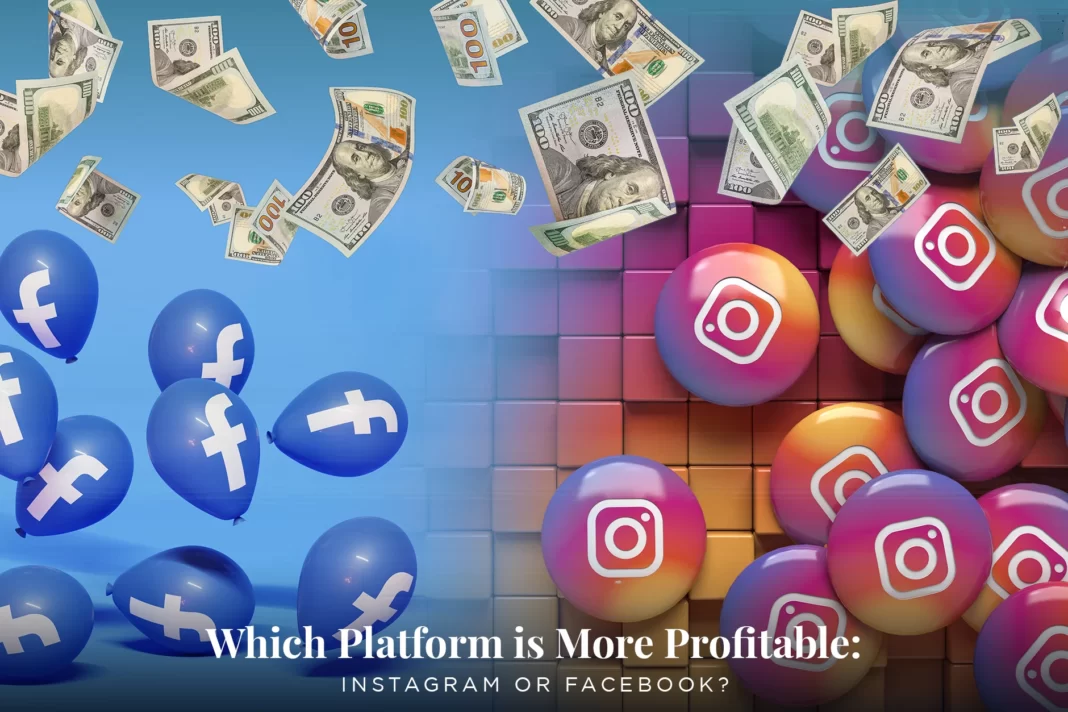The fight. who is winning? Can you compare these two platforms?
The two most popular platforms in social media marketing are Instagram and Facebook. However, when it comes to profitability, which platform reigns supreme? In this blog post, we will compare Instagram and Facebook to determine which platform is more profitable for businesses.
- Audience Size and Demographics
When marketing, understanding the size and demographics of a platform’s audience is essential. It allows businesses to create content that resonates with their target audience and increase the effectiveness of their social media marketing campaigns.
Facebook has a more extensive user base than Instagram, with over 2.8 billion monthly active users. However, the platform’s audience demographics are more diverse, with a roughly equal split between male and female users and a more comprehensive range of age groups. According to Statista, the largest age group on Facebook is between 25-34 years old, making up 22% of users. The platform also has a significant number of users aged 35-44, at 19% of the user base.
On the other hand, Instagram has a younger and more engaged audience. According to Hootsuite, 72% of Instagram users are under the age of 35, with the majority of users falling into the 18-24 and 25-34 age brackets. Instagram’s audience is predominantly female, with women making up 57% of the user base.
The difference in audience demographics between Facebook and Instagram is essential for businesses to consider when deciding which platform to focus their social media marketing efforts on. If a business’s target audience is primarily younger, female, and visually oriented, then Instagram may be the more profitable platform. However, if a company targets a more comprehensive age range or a more diverse demographic, then Facebook may be the better choice.
It’s also worth noting that while Facebook has a more extensive user base overall, it’s essential to consider the active user base on each platform. While Facebook may have more users, if a significant portion of those users is inactive or not engaging with content, it may not be as profitable of a platform for businesses as Instagram.
Winner: Instagram
- Engagement and Reach
Engagement and reach are two key metrics that businesses should consider when determining the profitability of a social media platform. Engagement is the quantity and quality of user involvement and activity with a brand’s social media material. The number of individuals who see a brand’s social media material is called reach.
Instagram’s algorithm is designed to give preference to aesthetically attractive material, which makes it simpler for companies to produce exciting content that appeals to their target audience. Instagram’s platform also includes various features, such as hashtags, Stories, and Reels, encouraging users to engage with content. Hashtags, in particular, allow businesses to increase their reach and target specific audiences by including relevant keywords in their posts.
In addition to these features, Instagram’s format lends itself well to user engagement. Users can like, comment, and share posts, allowing them to participate actively in conversations and discussions with brands. This level of engagement can lead to increased brand awareness, as users are more likely to share and recommend content they enjoy.
In contrast, Facebook’s algorithm prioritizes content from friends and family over branded content. This can make it more difficult for businesses to reach their target audience organically. However, Facebook offers paid advertising options to help companies to increase their reach. These options include boosted posts, sponsored content, and Facebook ads.
Winner: Instagram
- Advertising Options and Costs
Advertising options and costs are also important factors to consider when determining the profitability of a social media platform for businesses. Instagram and Facebook offer various advertising options, each with strengths and weaknesses.
Facebook’s advertising platform offers various targeting options, including demographics, interests, behaviors, and locations. This allows businesses to target specific audiences with their ads, increasing the chances of reaching users interested in their products or services. Facebook also offers a range of ad formats, including image, video, and carousel ads, which can be customized to suit a brand’s specific needs.
Instagram’s advertising options are similar to Facebook’s, with various formats available, including photo, video, carousel, and Stories ads. Instagram’s platform also offers to target options based on demographics, interests, and behaviors and additional targeting options such as interests and behaviors specific to Instagram users.
Regarding costs, both platforms use an auction-based system, where advertisers bid for ad space. The cost of advertising on both platforms will depend on various factors, including the target audience, ad format, and level of competition. Generally speaking, advertising costs on Facebook are higher than on Instagram due to Facebook’s more extensive user base and more diverse audience demographics.
However, the cost of advertising on either platform can vary widely depending on the specific targeting options, and ad format chosen. Businesses should carefully consider their advertising budget and goals before deciding which platform to focus their efforts on.
Winner: Tie
- E-commerce Features
E-commerce features are another essential factor to consider when determining the profitability of a social media platform for businesses. Instagram and Facebook have introduced various e-commerce features recently, allowing companies to sell products directly through their social media accounts.
Instagram’s e-commerce features include tagging products in posts and stories and adding a Shop tab to a business profile. When users click on a product tag or the Shop tab, they are taken to a product detail page where they can view additional information about the product and make a purchase.
Facebook also offers a range of e-commerce features, including the ability to create a Shop section on a business page, as well as the ability to sell products directly through Facebook Marketplace. Businesses can also use Facebook’s advertising platform to create dynamic ads that showcase their products and encourage users to purchase.
Both platforms also offer integration with third-party e-commerce platforms, such as Shopify and BigCommerce, allowing businesses to manage their social media sales and inventory in one place.
The addition of e-commerce features to social media platforms has made it easier for businesses to sell products directly to their target audience without users needing to leave the venue. This can lead to increased sales and revenue for companies and user convenience.
Winner: Instagram (iammandyb is not on Instagram, Instagram is giving me stress for likes and followers).
Conclusion
In the battle of Instagram vs. Facebook, Instagram emerges as the more profitable business platform. Its younger, engaged audience and visual-focused algorithm make it easier for businesses to create engaging content and reach their target audience. While Facebook has a more extensive user base and lower advertising costs, its algorithm can make it harder for businesses to reach their target audience organically.




